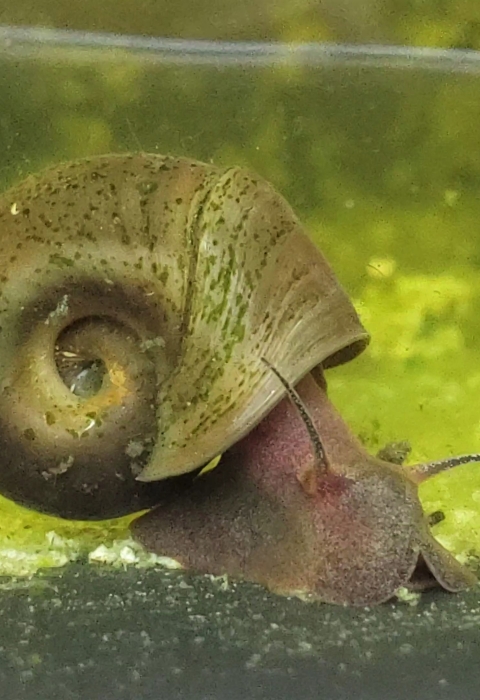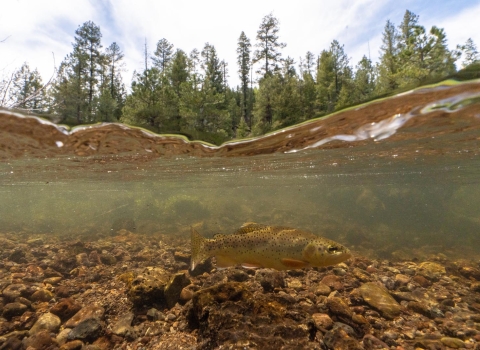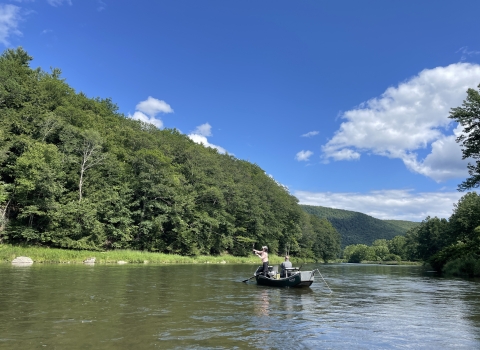The U.S. Fish and Wildlife Service has finalized regulations under the Endangered Species Act (ESA) to protect the magnificent ramshorn snail from extinction.
This air-breathing aquatic snail is known from only four sites in the lower Cape Fear River Basin in southeastern North Carolina. Despite surveying over 100 potential sites (including most historical locations) over the last few decades, no magnificent ramshorn snails have been found in the wild.
Classified as an endangered species, the ramshorn is now protected from “take,” and being traded or sold. The Service also designated 739 acres in Brunswick County, North Carolina, as critical habitat for magnificent ramshorn. Two ponds are within the critical habitat designation - Orton Pond and Big Pond (also known as Pleasant Oaks Pond).
Since 1992, captive populations ensure the survival of the species, but catastrophes such as severe storms, disease, or predator infestations make them vulnerable to extinction. Three captive populations currently exist, with about 1,000 snails. Captive breeding is underway to release ramshorn snails back into their wild habitats to restore the species.
To reestablish ramshorn populations in the designated critical habitat areas, specific habitat conditions must be met for the ramshorn to thrive. Working with state fish and wildlife agencies and our partners will help advance conservation efforts and the eventual recovery of the species.
The magnificent ramshorns in captivity are descendants of adult snails from two wild populations. A study by North Carolina State University and the North Carolina Wildlife Resources Commission is underway to determine the genetic diversity of the captive populations. The North Carolina Division of Water Resources and the Service are working with the city of Wilmington, North Carolina, to improve the water quality of Greenfield Lake that formerly supported the species.
The NC Wildlife Resources Commission recently received an ESA Section 10 Enhancement of Survival Permit from the Service for a Safe Harbor Agreement for 21 aquatic species, including the magnificent ramshorn. The permit enables the state to enroll private and other non-Federal property owners in a program to implement conservation actions for federally listed and at-risk species. The agreement assures landowners that they will not be subjected to increased property use restrictions as a result of their efforts to either attract listed species to their property or increase the numbers or distribution of listed species already on their property. The combined power of these legal tools will remove obstacles and help the agencies work with private landowners to reintroduce the species to its historical range.
The most significant stressors that likely led to the extirpation of the magnificent ramshorn are loss of pond habitats and impaired water quality from saltwater intrusion, pollutant influx, and human alteration of aquatic vegetation communities. Furthermore, the species' historical range is limited to non-flowing waters or ponds within the Coastal Plain of southeastern North Carolina. Providing critical habitat in areas uninhabited by the magnificent ramshorn will ensure a safe environment to return and thrive. Through conservation of the designated areas, we can address the factors that caused the snail's decline, so the snail will be able to flourish there once again. Critical habitat does not prevent development or other activities. It will only impact activities that require a federal permit or funding and are likely to destroy or adversely modify the critical habitat.
The Service will capture a vision of what the magnificent ramshorn's recovered state looks like in a recovery plan, and a separate "stepped-down" Recovery Implementation Strategy. Because the snail likely disappeared from the wild, experts agree three actions will be needed: 1) keeping at least two secure captive populations until there are enough in the wild to eliminate the need for captive breeding; 2) reintroducing magnificent ramshorn snails to at least two historical locations; and 3) introducing magnificent ramshorn snails to at least two other locations within the species' historical range. The public will have an opportunity to review and comment on the recovery plan. The supplemental Recovery Implementation Strategy is a more flexible operational document that outlines how, when, and with whom recovery actions will be implemented.
The magnificent ramshorn is an aquatic pulmonate snail. “Pulmonate” snails, breathe air by means of a lunglike organ, and do not breathe water via gills. They lack an operculum, a hard “trapdoor” that other types of aquatic snails possess that closes when the animal retracts into the shell.
In August 2022, the Service proposed listing the magnificent ramshorn snail and proposed critical habitat. During a 60-day comment period, nearly every comment submitted expressed support for the proposed rule. Comments have all been addressed within the final listing rule.
For more information, please visit the magnificent ramshorn species profile and the Frequently Asked Questions from the proposed listing announcement.
The mission of the U.S. Fish and Wildlife Service is working with others to conserve, protect, and enhance fish, wildlife, plants, and their habitats for the continuing benefit of the American people. For more information on our work and the people who make it happen, visit www.fws.gov. Connect with our Facebook page at www.facebook.com/usfwssoutheast, follow our tweets at www.twitter.com/usfwssoutheast, watch our YouTube Channel at http://www.youtube.com/usfws and download photos from our Flickr page at http://www.flickr.com/photos/usfwssoutheast.



